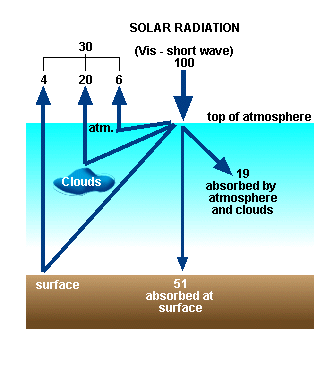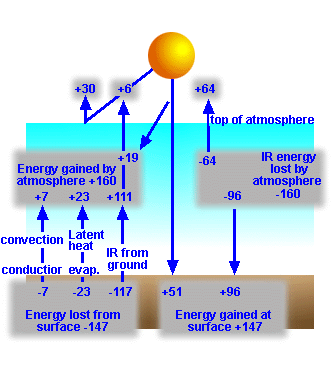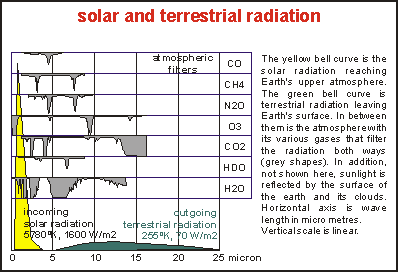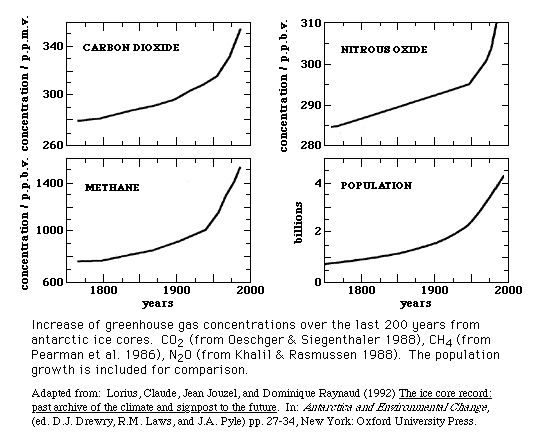|
||||||||||||||||||||||||||||||||||||||||||||||||||||||||||||||||||||||||||||||||||||||||||||||||||||||||||||||||||||||||||||||||||||||
|
Sources and impacts of greenhouse gases |
||||||||||||||||||||||||||||||||||||||||||||||||||||||||||||||||||||||||||||||||||||||||||||||||||||||||||||||||||||||||||||||||||||||
Take away ideas and understandings:
1.0 Introduction to the greenhouse effect: Radiative ForcingThe temperature
of the Earth's surface and atmosphere are dictated by a balance between
incoming energy and outgoing energy. When more energy is received
than lost, temperatures rise. The Earth's surface, for example, absorbs
radiation from the Sun. This energy is then redistributed by the atmospheric
and oceanic circulations and radiated back to space at longer (infrared)
wavelengths. For the annual mean and for the Earth as a whole, the
incoming solar radiation energy is balanced approximately by the outgoing
terrestrial radiation. Any factor that alters the radiation received
from the Sun or lost to space, or that alters the redistribution of
energy within the atmosphere and between the atmosphere, land, and
ocean, can affect climate. A change in the net radiative energy available
to the global Earth-atmosphere system is termed a radiative forcing.
Positive radiative forcings tend to warm the Earth’s surface
and lower atmosphere. Negative radiative forcings tend to cool them. Increases in the
concentrations of greenhouse gases will reduce the efficiency with
which the Earth’s surface radiates to space. More of the outgoing
terrestrial radiation from the surface is absorbed by the atmosphere
and re-emitted at higher altitudes and lower temperatures. This results
in a positive radiative forcing that tends to warm the lower atmosphere
and surface. Because less heat escapes to space, this is the enhanced
greenhouse effect – an enhancement of an effect that has
operated in the Earth’s atmosphere for billions of years due
to the presence of naturally occurring greenhouse gases: water vapor,
carbon dioxide, ozone, methane and nitrous oxide. The amount of radiative
forcing depends on the size of the increase in concentration of each
greenhouse gas, the radiative Anthropogenic aerosols (microscopic airborne particles or droplets) in the troposphere, such as those derived from fossil fuel and biomass burning, can reflect solar radiation, which leads to a cooling tendency in the climate system. Because it can absorb solar radiation, black carbon (soot) aerosol tends to warm the climate system. In addition, changes in aerosol concentrations can alter cloud amount and cloud reflectivity through their effect on cloud properties and lifetimes. In most cases, tropospheric aerosols tend to produce a negative radiative forcing and a cooler climate. They have a much shorter lifetime (days to weeks) than most greenhouse gases (decades to centuries), and, as a result, their concentrations respond much more quickly to changes in emissions. Volcanic activity can inject large amounts of sulphur-containing gases (primarily sulfur dioxide) into the stratosphere, which are transformed into sulfate aerosols. Individual eruptions can produce a large, but transitory, negative radiative forcing, tending to cool the Earth’s surface and lower atmosphere over periods of a few years. When radiative forcing changes, the climate system responds on various time-scales. The longest of these are due to the large heat capacity of the deep ocean and dynamic adjustment of the ice sheets. This means that the transient response to a change (either positive or negative) may last for thousands of years. Any changes in the radiative balance of the Earth, including those due to an increase in greenhouse gases or in aerosols, will alter the global hydrological cycle and atmospheric and oceanic circulation, thereby affecting weather patterns and regional temperatures and precipitation. Shortwave Radiation BudgetSolar radiation entering the Earth's atmosphere (called "shortwave" radiation) can be reflected off clouds, the surface, and air molecules and dust. On a global average this accounts for about 30% of incoming radiation. This percentage is quantified as the albedo of the system. Albedo = percentage of incoming radiation that is reflected back into space = 30% for Earth Another 19% on
average is absorbed by the atmosphere, mainly by ozone in the Earth's
stratosphere. The remaining 51% is absorbed by the Earth's surface.
Over a long term average, the Earth and its atmosphere must radiate as much energy out to space as it receives from the sun, but over the course of a year or a day or as one moves geographically it is likely that such a balance will not be present. At night and in the winter, for example, there is less solar radiation producing an energy deficit and leading to lower temperatures at those times in general. In order to understand the whole energy balance we must also consider the other means for exchanging energy between the Earth's surface, atmosphere and space.
Longwave Radiation BudgetAs was learned in the beginning of the semester all objects emit radiation in an amount and at a wavelength dictated by the object's temperature. The 51% of shortwave radiation absorbed by the Earth's surface heats the surface. But as the surface heats it emits radiation in the infrared back into the atmosphere. The figure below
shows the annual global average exchange of energy between the Earth's
surface and the atmosphere. Note the 51% of original solar radiation
is absorbed, but 117% of the original solar input is emitted to the
atmosphere, how can this be? The answer makes sense when we consider that the surface of a planet receives a great deal of energy from its own atmosphere. Thus the effect of the atmosphere is to warm the surface over the temperature above that resulting from the Sun's energy. The atmosphere warms the Earth by "trapping" radiation, allowing the surface to warm to 300°K. At that temperature, the black body surface radiation is large enough to ensure that an equilibrium condition pertains. The atmosphere traps radiation through the action of certain gases, called Greenhouse Gases. These gases (e.g., CO2, H2O, NO, CFCs, CO) are very good at absorbing and re-emitting infrared radiation. They intercept the IR radiation from the ground and reflect some of the energy back to the ground, warming it up more than would occur otherwise.
"Selective absorbers" - Greenhouse gasThe main greenhouse gas constituents in the atmosphere - CO2, CO, H2O, CH4, N2O, and tropospheric ozone act as "selective absorbers", meaning that each compound absorbs outgoing IR radiation at a specific wavelength or range/set of wavelengths. Note that global warming contribution from ozone is NOT the ozone in the stratosphere ("good" ozone, which blocks harmful UV-B band in solar radiation), but the ozone generated by exhausts which remain in the loewr troposphere ("bad" ozone). As you can see below, these compounds "selectively absorb" part of the outgoing IR radiation:
2.0 History of greenhouse gas accumulation in the atmosphereAs shown below, nearly all greenhouse gases are on the increase. |
||||||||||||||||||||||||||||||||||||||||||||||||||||||||||||||||||||||||||||||||||||||||||||||||||||||||||||||||||||||||||||||||||||||
|
GAS |
MAJOR ANTHROPOGENIC SOURCES |
Anthropogenic |
AVERAGE RESIDENCE
TIME IN ATMOSPHERE
|
AVERAGE CONCENTRATION 100 YEARS AGO (PPB) |
APPROXIMATE CURRENT CONCENTRATION (PPB) |
PROJECTED CONCENTRATION
|
|
CARBON MONOXIDE (CO) |
Fossil-Fuel Combustion,
|
700/ |
Months
|
?, N. Hem. |
100-200, N. Hem. |
Probably increasing |
|
CARBON DIOXIDE (CO2) |
Fossil-Fuel Combustion, Deforestation |
5,500/ |
100 Years
|
290,000 |
350,000 |
400,000-550,000 |
|
METHANE (CH4) |
Rice Fields, Cattle, Landfills,
|
300-400/ |
10 Years
|
900 |
1,700 |
2,200-2,500 |
|
NOX |
Fossil-Fuel Combustion,
|
20-30/ |
Days
|
.001 to ? |
.001-50 |
.001-50 |
|
NITROUS OXIDE (N2O) |
Notrogenous |
6/ |
170 Years
|
285 |
310 |
330-350 |
|
SULFUR DIOXIDE (SO2) |
Fossil-Fuel Combustion, Ore Smelting |
100-130/ |
Days to Weeks
|
.03 to ? |
.03-50 |
.03-50 |
|
CHLORO- FLUORO- CARBONS |
Aerosol Sprays, Refrigerants,
|
-1/1 |
60-100 Years
|
0 |
About 3 |
2.4-6 |
The main human activities that increase greenhouse gases are energy use (automobiles, goods tranport, etc), air conditioning, and agriculture.
The US is the leading greenhouse gas emitter, comprising nearly 20% of the global average emissions. The former soviet republics comprise the next largest joint emitter at near 14% of gloabl emisions, followed by China (10%), Japan (5%), Brazil, Germany, and India (each ~4%).
Future emissions depend, in part, on the changing demography of individual nations and on adaptation of future technologies. Significantly, the US and Europe will only comprise ~3-10% of future fossil fuel usage, whereas China and India are projected to lead consumption, having nearly tripled their consumption over the last twenty years.
4.0 Greenhouse gas "Global Warming Potential"
The Global Warming Potential (GWP) of a greenhouse gas is the ratio of global warming, or radiative forcing – both direct and indirect – from one unit mass of a greenhouse gas to that of one unit mass of carbon dioxide over a period of time. Hence this is a measure of the potential for global warming per unit mass relative to carbon dioxide.
Global Warming Potentials are presented in Table 1 for an expanded set of gases. GWPs are a measure of the relative radiative effect of a given substance compared to CO2, integrated over a chosen time horizon. New categories of gases in Table 1 include fluorinated organic molecules, many of which are ethers that are proposed as halocarbon substitutes. Some of the GWPs have larger uncertainties than that of others, particularly for those gases where detailed laboratory data on lifetimes are not yet available. The direct GWPs have been calculated relative to CO2 using an improved calculation of the CO2 radiative forcing, the SAR response function for a CO2 pulse, and new values for the radiative forcing and lifetimes for a number of halocarbons. Indirect GWPs, resulting from indirect radiative forcing effects, are also estimated for some new gases, including carbon monoxide. The direct GWPs for those species whose lifetimes are well characterized are estimated to be accurate within ±35%, but the indirect GWPs are less certain.
| Table 1. Direct Global Warming Potentials (GWPs) relative to carbon dioxide (for gases for which the lifetimes have been adequately characterized). GWPs are an index for estimating relative global warming contribution due to atmospheric emission of a kg of a particular greenhouse gas compared to emission of a kg of carbon dioxide. GWPs calculated for different time horizons show the effects of atmospheric lifetimes of the different gases. | |||||
| Lifetime | Global Warming Potential | ||||
| (years) | (Time Horizon in Years) | ||||
| GAS | 20 yrs | 100 yrs | 500 yrs | ||
| Carbon Dioxide | CO2 |
|
1
|
1
|
1
|
| Methane | CH4 |
12
|
62
|
23
|
7
|
| Nitrous Oxide | N2O |
114
|
275
|
296
|
156
|
| Chlorofluorocarbons |
|
|
|
|
|
| CFC-11 |
55
|
4500
|
3400
|
1400
|
|
| CFC-12 |
116
|
7100
|
7100
|
4100
|
|
| CFC-115 |
550
|
5500
|
7000
|
8500
|
|
5.0 Relative warming contributions of different greenhouse gases
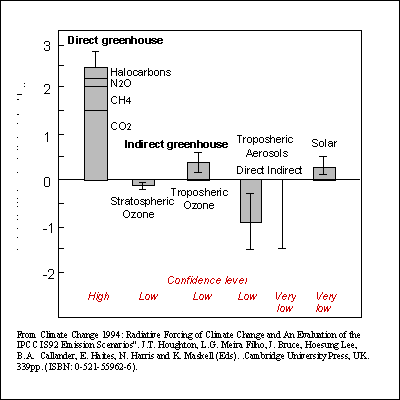

6.0 The rise in atmospheric carbon dioxide
Updated April 15, 2002
©2002 P. deMenocal (LDEO, Columbia Univ.)

